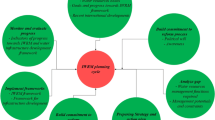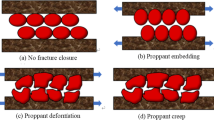Abstract
Hydraulic fracturing has become a crucial method for exploiting shale gas. The test production of shale gas wells can be significantly impacted by different shut-in times and flowback systems, making these data vital for formulating development plans formulation and evaluating productivity. This study proposes a workflow of field shut-in experiments combined with chloride ion concentration observations, using the engineering method. Moreover, the study optimizes some reservoir testing details in the study area (the best testing time was 22 days, and the optimal shut-in time is 30 days). The conclusions of this study are as follows: (1) each production area can be optimized on geological conditions and engineering data statistics, and the combined analysis of microseismic monitoring and well shut-in experiments can yield the optimal value for multiple factors. (2) The observation of chloride ion concentration, as part of the geochemical method, can easily determine the storage characteristics, distribution status, and return characteristics of the drainage fluid in the reservoir. Furthermore, the well shut-in experiment can accurately assess the impact of the drainage and mining working system on production capacity. (3) The present study shows that when the chloride ion concentration of the drainage fluid tends to stabilize over a long period, the reservoir test can be concluded, and normal production can commence.







Similar content being viewed by others
References
Cramer, D.D.; Nguyen, D. H.: Diagnostic fracture injection testing tactics in unconventional reservoirs. In: SPE Hydraulic Fracturing Technology Conference. OnePetro (2013)
Ameen, M.S.; Hailwood, E.A.: A new technology for the characterization of microfractured reservoirs (test case: Unayzah Reservoir, Wudayhi Field, Saudi Arabia). AAPG Bull. 92(1), 31–52 (2008)
Saberhosseini, S.E.; Ahangari, K.; Mohammadrezaei, H.: Optimization of the horizontal-well multiple hydraulic fracturing operation in a low-permeability carbonate reservoir using fully coupled XFEM model. Int. J. Rock Mech. Min. Sci. 114, 33–45 (2019)
Damjanac, B.; Cundall, P.: Application of distinct element methods to simulation of hydraulic fracturing in naturally fractured reservoirs. Comput. Geotech. 71, 283–294 (2016)
Ouenes, A., et al.: Integrated characterization and simulation of the fractured Tensleep reservoir at Teapot Dome for CO2 injection design. In: SPE Western Regional Meeting. OnePetro (2010)
Ghanbari, E.; Dehghanpour, H.: The fate of fracturing water: a field and simulation study. Fuel 163, 282–294 (2016)
Gu, K.; Ning, Z.; Kang, Y.: Moisture influence on organic pore structure of shale. Arab. J. Geosci. 14(24), 1–11 (2021)
Liu, J., et al.: Experimental investigation on hydration mechanism of Sichuan shale (China). J. Pet. Sci. Eng. 201, 108421 (2021)
**g, G., et al.: Influence of different shut-in periods after fracturing on productivity of MFHW in Duvernay shale gas formation with high montmorillonite content. Fuel 314, 122719 (2022)
Tao, L., et al.: Experimental study on water imbibition law of Longmaxi Formation Shale in the Sichuan Basin. In: International Petroleum Technology Conference. OnePetro (2021)
Khan, S.; Al-Shuhail, A.A; Khulief, Y.A.: Numerical modeling of the geomechanical behavior of Ghawar Arab-D carbonate petroleum reservoir undergoing CO2 injection. Environ. Earth Sci. 75, 1499 (2016)
Jiang, X., et al.: Study on the feasibility of the heat treatment after shale gas reservoir hydration fracturing. Energy 254, 124422 (2022)
Changgui, J., et al.: Experimental study on microstructure and mechanical properties of lacustrine shale under water-rock interaction. Arab. J. Geosci. 15(11), 1–13 (2022)
Yuan, B.; Wang, Y.; Shunpeng, Z.: Effect of slick water on permeability of shale gas reservoirs. J. Energy Resour. Technol. 140(11), 112901 (2018)
Rahm, B.G., et al.: Wastewater management and Marcellus Shale gas development: trends, drivers, and planning implications. J. Environ. Manag. 120, 105–113 (2013)
Al-Ameri, A.; Gamadi, T.; Ispas, I.: Evaluation of the near fracture face formation damage caused by the spontaneously imbibed fracturing fluid in unconventional gas reservoirs. J. Pet. Sci. Eng. 171, 23–36 (2018)
Nie, H., et al.: An overview of the geology and production of the Fuling shale gas field, Sichuan Basin, China. Energy Geosci. 1(3–4), 147–164 (2020)
Yi, J., et al.: Main factors controlling marine shale gas enrichment and high-yield wells in South China: a case study of the Fuling shale gas field. Mar. Pet. Geol. 103, 114–125 (2019)
Wei, S., et al.: Models of shale gas storage capacity during burial and uplift: application to Wufeng-Longmaxi shales in the Fuling shale gas field. Mar. Pet. Geol. 109, 233–244 (2019)
Guo, X., et al.: Geological factors controlling shale gas enrichment and high production in Fuling shale gas field. Pet. Explor. Dev. 44(4), 513–523 (2017)
Shi, W., et al.: Investigation of the origin of low resistivity and methods for the calculation of gas saturation in shale gas reservoirs in the Fuling Area. Energy Fuels 35(6), 5181–5193 (2021)
Guo, X., et al.: Hydrocarbon generation and storage mechanisms of deep-water shelf shales of Ordovician Wufeng Formation-Silurian Longmaxi Formation in Sichuan Basin, China. Pet. Explor. Dev. 47(1), 204–213 (2020)
Gou, Q., et al.: Full-scale pores and micro-fractures characterization using FE-SEM, gas adsorption, nano-CT and micro-CT: a case study of the Silurian Longmaxi Formation shale in the Fuling area, Sichuan Basin, China. Fuel 253, 167–179 (2019)
Osselin, F., et al.: Geochemical and sulfate isotopic evolution of flowback and produced waters reveals water-rock interactions following hydraulic fracturing of a tight hydrocarbon reservoir. Sci. Total Environ. 687, 1389–1400 (2019)
Haluszczak, L.O.; Rose, A.W.; Kump, L.R.: Geochemical evaluation of flowback brine from Marcellus gas wells in Pennsylvania, USA. Appl. Geochem. 28, 55–61 (2013)
Saw, A., et al.: Comparative geochemistry of flowback chemistry from the Utica/Point Pleasant and Marcellus formations. Chem. Geol. 564, 120041 (2021)
Bustin, R. M., Owen, J., Bustin, A.: Insights into reservoir dynamics of the Montney Formation from analysis of flowback and produced fluids, petrophysics, and fluid compatibility modeling. In: 2018 AAPG International Conference and Exhibition (2020)
Bertoncello, A., et al.: Imbibition and water blockage in unconventional reservoirs: well management implications during flowback and early production. SPE Reserv. Eval. Eng. 17(04), 497–506 (2014)
Abbasi, M.A.; Ezulike, D.O.; Dehghanpour, H.: A comparative study of flowback rate and pressure transient behavior in multifractured horizontal wells completed in tight gas and oil reservoirs. J. Nat. Gas Sci. Eng. 17, 82–93 (2014)
Wang, F., et al.: Simulation of coupled hydro-mechanical-chemical phenomena in hydraulically fractured gas shale during fracturing-fluid flowback. J. Pet. Sci. Eng. 163, 16–26 (2018)
Lei, Z., et al.: Experiment on the relationship between the characteristics of flowback liquid ions and the complexity of hydraulic fractures in shale. In: 2020 2nd International Conference on Artificial Intelligence and Advanced Manufacture (AIAM) 2020.000000000
Author information
Authors and Affiliations
Corresponding author
Rights and permissions
Springer Nature or its licensor (e.g. a society or other partner) holds exclusive rights to this article under a publishing agreement with the author(s) or other rightsholder(s); author self-archiving of the accepted manuscript version of this article is solely governed by the terms of such publishing agreement and applicable law.
About this article
Cite this article
Yang, Y., Liu, Z. Experimental Study on Field Actual Shut-In After Fracturing of Shale Gas Reservoir. Arab J Sci Eng 48, 16941–16951 (2023). https://doi.org/10.1007/s13369-023-08249-y
Received:
Accepted:
Published:
Issue Date:
DOI: https://doi.org/10.1007/s13369-023-08249-y




